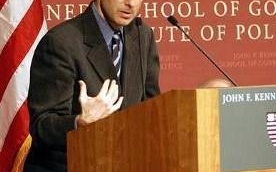Following the recent Japanese earthquake and tsunami, policy makers in Japan have struggled to find a solution to the structural, and economic problems caused by the disaster, Japanese economist Hiroshi Nakaso said yesterday at the Harvard Kennedy School.
Nakaso, who is the Assistant Governor of the Bank of Japan, discussed the problems with Japanese infrastructure that exacerbated the crisis after last month’s catastrophic earthquake, as well as elaborating on what financial experts were doing to prevent a sharp contraction of the economy.
“What is ironic is that just before the earthquake, economists were saying that the Japanese economy was performing better than expected,” said Nakaso.
While the Cabinet Office of Japan believed that the damage to industry totalled roughly 16 to 25 trillion yen—an amount which would paralyze production in coastal Japan for some time—Nakaso said he remains optimistic.
He went on to say that three challenges that would slow the Japanese recovery were the electrical power supply shortage, the supply chain disruption, and the Fukushima Dai-ichi Nuclear Plant disaster.
Nakaso noted that the largest Japanese power plant lost 40 percent of its capacity due to the earthquake—requiring large industrial users to cut down 25 percent of their electrical use in peak hours during the summer, when electricity consumption is at its highest.
Additionally—in one of the more puzzling and little known infrastructure problems—plants in western Japan generate electricity at different frequencies from those in eastern Japan, which has prevented western plants from transferring some of their excess capacity to disaster-stricken eastern areas, Nakaso said.
Nakaso also discussed some of the measures taken to keep Japan’s economy afloat, mentioning that during the first business day after the earthquake, the Bank of Japan injected a record high 21.8 trillion yen into the economy, increasing both liquidity and investors’ confidence.
He said he believes that the economy could be boosted by reconstruction demand, a view he said was shared by the International Monetary Fund.
“We have a precedent to believe that GDP will not go negative, because after [the] Hanshin Earthquake in 1995, GDP remained positive for most of the period after the earthquake”, Nakaso said.
During a question-and-answer session, audience members highlighted their own perceptions of Japan’s problems.
School of Public Health graduate Christine Huttin brought up concerns about nuclear safety and regulation. Nakaso responded that Japan would develop stronger regulations in the wake of the disaster.
Nakaso said he was especially moved by how the Japanese youth was taking an active role in the wake of the earthquake.
“They are voluntarily helping people in the disaster region. It’s reviving the activity and vigor of Japanese youngsters,” he said. “I am hopeful that this tragedy could change the course of Japan in the future.”
Read more in News
Lipinski Selected As New Nieman CuratorRecommended Articles
-
Harvard Welcomes Japanese History ProfessorDavid L. Howell, currently a professor of Japanese Studies at Princeton University, will join the East Languages and Civilizations Department in July.
-
 'Justice' Makes It to Japan
'Justice' Makes It to Japan -
Japanese Historian Bolsters EALC DepartmentTomiko Yoda, an intellectual and cultural historian who focuses on Japanese literary texts, will be joining the East Asian Language and Civilizations Department as a full professor in the coming academic year, bolstering the department's faculty body after it sustained four losses over the last few years.
-
 Scholars Discuss Recovery in Japan
Scholars Discuss Recovery in Japan -
Harvard Square Businesses Help JapanThree weeks after the March 11 earthquake that devastated Japan, Harvard Square businesses will be teaming up for a bake sale to benefit relief efforts this Saturday at Upstairs on the Square.
-
 Harvard Students and Faculty Aid Japanese Recovery Effort
Harvard Students and Faculty Aid Japanese Recovery Effort













